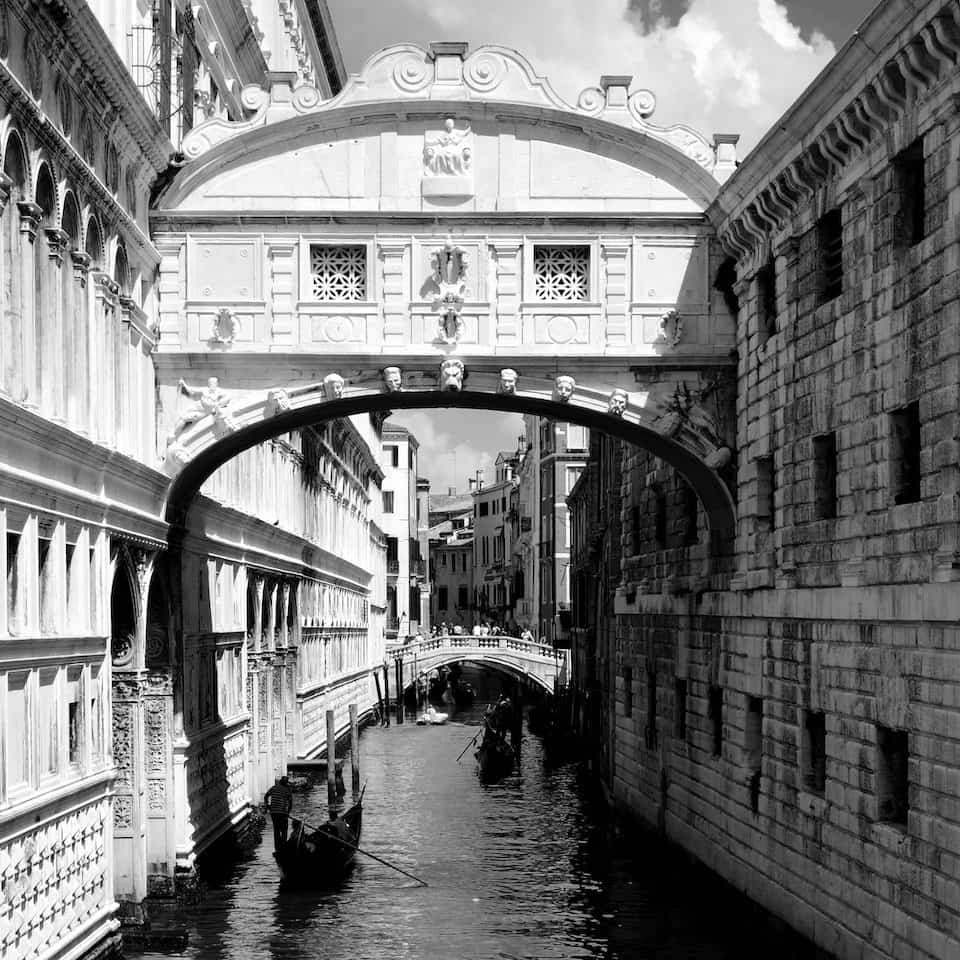Review: Sony QX10 vs QX100 lens style cameras
Bridge of Sighs; (cc) by-nc squics.com
I believed that the name of the bridge had something to do with romance; the bridge is in Venice after all. But I was wrong. It's not about with romance. Condemned criminals had to cross it on their way from the Doge’s Palace to the dungeon. They took a last look at the lagoon, which elicited a sigh from many.
In Venice, I photographed only with my iPhone and the Sony QX100 smartphone attachable lens style camera. It was liberating; no more heavy and bulky equipment to carry around.
Originally, I edited the photo on my laptop using Intensify Pro, a photo editing software that does what the name suggests. I recently re-edited the photo using only an iPhone.
One more thing that I learned to appreciate on this trip, was the Sony QX100 attachable lens style camera.
It allows you to shot 20 megapixel photos, well, with your smartphone.
The Sony DSC-QX10 and DSC-QX100 are digital compact cameras contained in a lens like housing. They don't have any controls except for an on/off switch, a shutter release and a zoom slider. You use your smartphone as a viewfinder, to adjust settings and to photograph.
The Sony QX attachable lens-style cameras communicate with your smartphone using WiFi. Sony Xperia users can use NFC to establish a WiFi connection. iPhone users have to manually pair the iPhone and the camera once.
The huge advantage of this camera is that it can work detached from the smartphone. In crowded places you hold the camera above the heads of the crowd with one hand and operate it with your other hand.
Sony sells two models; the DSC-QX10 with a 10x optical zoom and the DSC-QX100 with a Carl Zeiss lens and a 3.5x optical zoom.
I took both models for a test ride.
Connecting and handling the DSC-QX10 and DSC-QX100
The QX10 clearly wins the weight and size discipline. It's half the size of the QX100 and roughly half the weight. Therefore the QX10 is much more convenient to carry. However, the micro SD slot of the QX10 is hidden in the battery compartment. To change the SD card you need to remove the backplate and open the battery compartment.
The QX100 is bigger and heavier but comes with a Carl Zeiss lens that clearly beats the QX10 in quality. Additionally the SD card slot is located on the side of the housing and conveniently accessible.
Both models come with a exchangeable battery that's charged in the device using a micro USB cable. Both models have the USB plug on the side of the housing.
Both QX models connect with your smartphone using WiFi. Android and Sony Xperia users can use NFC to connect the camera and the phone. Gently tap the lens camera and your smartphone together and they'll connect.
iPhone users have to manually establish the WiFi connection once. After the WiFi connection has been established for the first time the camera and smartphone will automatically connect once both are turned on and the Play Memories app from Sony runs on the iPhone.
Located on the back of the lens cameras are two fold out brackets to mount the lens camera to your smartphone.
The free Play Memories app from the Android or iOS App Store is required to photograph and to change settings like shooting mode for the camera. By default, the app transfers a small preview image after each shot to your smartphone and displays it on the screen. You can change this behaviour and have the full sized photo transferred after each shot.
No matter which setting you choose, the full size photo is always saved on the micro SD card. The micro SD card is required to use the camera with its full resolution.
The differences between the DSC-QX10 and DSC-QX100
The five main differences between the lower priced QX10 and the more expensive QX100 are:
- Size and Weight: The QX10 is smaller and lighter than the QX100.
- Megapixels: The QX100 is capable of shooting 20 megapixel photos while the QX10 has 18.9 megapixels.
- Lens aperture: The QX10 has an aperture range of f3.3-5.9 while the QX100 comes with an aperture range of f1.8-4.9.
- Optical zoom: While the QX10 offers a 10x (25-250mm) optical zoom, the QX100 has a 3.5x (25-100mm) optical zoom.
- Sensor size: The QX10 has a sensor size of 6.17 x 4.55mm compared to the bigger 13.2 x 8.8 mm sensor of the QX100.
Basically those numbers mean:
- If you want photos with a higher quality, buy the QX100. The bigger aperture and bigger sensor will result in better photos. You have to trade in the optical zoom.
- If you prefer a high optical zoom factor but are not too picky about image quality, then go for the QX10.
Photo quality of the DSC-QX10 and DSC-QX100
I made a trip to the vienna zoo to test both cameras. For the first shot I went to the Karthago fountain, an artificial ruin of a fountain that has lots of detail and is a challenge for compact cameras.
I took two photos of the same scene; first with the QX10 and then with the QX100. I enlarged them by 200% to make the differences more visible.
Have a look at the tree trunk and the ornaments behind it. The photo I made with the QX100 has more contrast, more depth and better details than the photo from the QX10. You can see that quite well looking at the ornaments in the background. Also, the photo of the QX10 has more noise than the one I took with the QX100.
The QX100 clearly trumps the QX10 in terms of image quality. That's due to the better (Carl Zeiss) lens and the bigger image sensor.
Next I compared the zoom. Obviously the QX10 wins here with its 10x optical zoom. The first photo is from a QX10 at 25mm. The second one from a QX100 at maximum zoom level and the third from a QX10 at maximum zoom level.
When it comes to zooming, the QX10 beats the QX100.
Summary
Though the DSC-QX10 beats the DSC-QX100 in size, weight, optical zoom and price, the DSC-QX100 clearly wins when it comes to image quality. For me, the decision was simple: I will use the DSC-QX100 in the future.
Update June 2014:
I did a trip to Venice at the end of May. I didn't use my compact camera at all. The DSC-QX100 and the possibility to operate the camera on a tripod and a handheld monopod detached from a smartphone was an absolute killer feature.
Update Sep 2014:
There's even a (manual) way to shoot bracketed photos that are suitable to create an HDR.
Room for improvement
Nevertheless, there is room for improvement. The viewfinder sometimes lags
Update Sep. 2014:
Sony has updated the PlayMemories App with geotagging that has to be enabled in the settings of the PlayMemories app.
Buying recommendation
If you're looking for a small all-round extension to your smartphone with 10x zoom, you can get the Sony DSC-QX10 from Amazon, knowing that the picture quality is okay.
If you want better image quality, you'll benefit from the Carl Zeiss lens, the f1.8 aperture and the bigger sensor size make the Sony DSC QX100 probably a better choice. Also, the Sony QX100 is available from Amazon.
Care about some quick feedback about this article?







